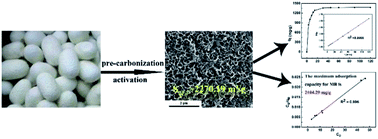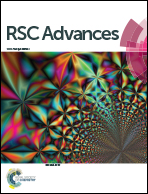Silkworm cocoon derived N, O-codoped hierarchical porous carbon with ultrahigh specific surface area for efficient capture of methylene blue with exceptionally high uptake: kinetics, isotherm, and thermodynamics†
Abstract
Dyes are typical water contaminants that seriously affect water quality. In this study, silkworm cocoon derived N, O-codoped hierarchical porous carbon was successively developed via a facile pre-carbonization and chemical activation method, and characterized thoroughly by SEM, TEM, HRTEM, XRD, Raman, N2 adsorption and XPS. The as-prepared N, O-HPC showed a well-developed porous structure with an ultra-high specific surface area of 2270.19 m2 g−1, which proved to be a high-efficiency adsorbent. Batch adsorption experiments demonstrated that MB adsorption was highly dependent on contact time, initial MB concentration, temperature and initial solution pH. However, no remarkable effects of humic acid and ionic strength were observed. In the kinetic studies, the good applicability of a pseudo-second-order kinetic model was demonstrated. The adsorption isotherm study showed that a Langmuir isotherm model can describe the experimental data much more suitably with a maximum monolayer adsorption capacity value of 2104.29 mg g−1, which is among the highest in previously reported adsorbents and ascribed to multiple adsorption mechanisms including pore filling, π–π stacking interaction and electrostatic interaction between MB and N, O-HPC. Thermodynamic analyses suggested that MB adsorption onto N, O-HPC was spontaneous and endothermic. Furthermore, the as prepared adsorbent showed highly efficient adsorption for MB in tap water and synergistic adsorption performance toward MB and MO. Therefore, N, O-HPC derived from silkworm cocoon could be considered as an efficient, novel and advantageous material for wastewater remediation.



 Please wait while we load your content...
Please wait while we load your content...